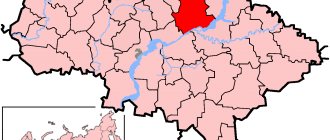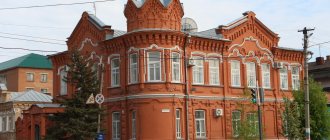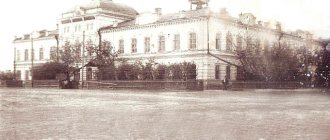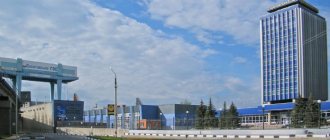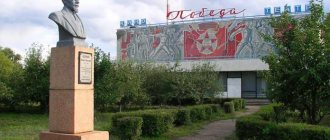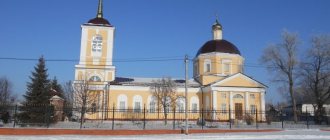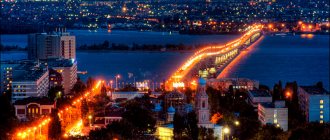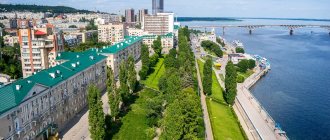Balakovsky municipal district
Balakovsky district
- a municipal entity in the Saratov region of Russia.
The administrative center is the city of Balakovo.
| A country | Russia, Russia |
| Status | Municipal district |
| Included in | Saratov region |
| Includes | 17 municipalities |
| Administrative center | Balakovo city |
| Date of formation | July 23, 1928 |
| Head of Administration of Balakovo Municipal District | Cheprasov Ivan Vasilievich |
| Population (2016) | ↘212 879[1] (8,56 %) |
| Density | 66.44 people/km² |
| Square | 3203.88[2]km² |
| Timezone | MSK (UTC+3) |
| Telephone code | 8 (8453) |
| Postal codes | 413800 |
| Auto code numbers | 64, 164 |
| [www.admbal.ru Official website] | |
| OKATO | [classif.spb.ru/classificators/view/okt.php?st=A&kr=1&kod=63207000000 63 207 000 000] |
Story
On December 8, 1921, by decree of the Presidium of the All-Russian Central Executive Committee, the Balakovo district was formed in the Samara province with its center in the city of Balakovo. In 1922, the Balakovo district of the Samara province included 20 volosts: Balakovskaya, Natalinskaya, Nikolevskaya, Goryainovskaya, Khlebnovskaya, Krasnoyarskaya, Kazenno-Mayangovskaya, Elanskaya, Pylkovskaya, Nikolsko-Kazakovskaya, Bykovo-Otrogskaya, Malo-Bykovskaya, Kormezhskaya, Krivoluchye-Surskaya , Kunye-Sarminskaya, Sukhootrogskaya, Malo-Perekopnovskaya, Sulakovskaya, Kamenno-Sarminskaya, Novo-Belkovskaya. The newspaper “Red Alarm” was published in the district. On May 8, 1924, Balakovo district was abolished, and its volosts were annexed to Pugachevsky district.
Balakovo district
formed on July 23, 1928 as part of the Volsky district of the Lower Volga region.
Since 1934, the district has been part of the Saratov Territory, since 1936 - in the Saratov Region.
Natural monuments
Natural monument of the Balakovo region.
Podsosensky Bor. Natural monuments of the Balakovo district of the Saratov region are natural objects protected by the state, having scientific, historical or cultural, educational and aesthetic significance (waterfalls, geological outcrops, unique trees). On the territory of the Balakovsky district of the Saratov region there are six natural monuments, including the Grachevskaya forest dacha,
located 30 km from
Balakovo
.
Here, in the open steppe, century-old oaks, elms, common elms, and green ash grow. Kormezhinsky Bor and Podsosensky Bor are also under protection
Municipal-territorial structure
By the Law of the Saratov Region of February 26, 2013 No. 15−ZSO[11], Golovanovskoe, Matveevskoe, Natalinskoe, Novonikolaevskoe, Novonikolevskoe and Podsosenskoe municipal formations were transformed, by merging, into the newly formed municipal formation “Natalyinskoe municipal formation of the Balakovo municipal district of the Saratov region” with the administrative center in the village of Natalino.
By Law of the Saratov Region dated April 28, 2015 No. 41-ZSO[12], Bykovo-Otrogskoe, Elanskoe, Komsomolskoe, Kormezhskoe, Krasnoyarskoe, Mayangskoe, Naumovskoe, Novoyeluzanskoe, Novopolevodinskoe, Pylkovskoe and Sukho-Otrogskoe municipalities were transformed, through merger, into again formed "Bykovo-Otrog municipality of the Balakovo municipal district of the Saratov region" with the administrative center in the village of Bykov Otrog.
There are 48 settlements in the Balakovo region, consisting of one urban and two rural settlements:
| № | Urban and rural settlements | Administrative center | Number of settlements | Population | Area, km2 |
| 1 | Municipal formation city of Balakovo | Balakovo city | 1 | ↘192 359[1] | 75,51[2] |
| 2 | Bykovo-Otrog municipality | Bykov Otrog village | 34 | ↗13 490[1] | 125,41[2] |
| 3 | Natalya municipality | village of Natalino | 13 | ↘7030[1] | 872,92[2] |
| List of settlements in the region | ||||
| № | Locality | Type | Population | Municipality |
| 1 | Andreevka | village | 212[3] | Natalya municipality |
| 2 | Balakovo | city | ↘192 359[1] | Municipal formation city of Balakovo |
| 3 | Barvenkovsky | village | 28[3] | Natalya municipality |
| 4 | Coastal | village | 130[3] | Bykovo-Otrog municipality |
| 5 | Berezovka | village | 100[3] | Bykovo-Otrog municipality |
| 6 | Bitelyak | farm | 37[3] | Bykovo-Otrog municipality |
| 7 | Big Kushum | village | 309[3] | Bykovo-Otrog municipality |
| 8 | Bykov Spur | village | ↗1265[10] | Bykovo-Otrog municipality |
| 9 | Golovanovsky | village | 695[3] | Natalya municipality |
| 10 | Gorino | farm | 103[3] | Bykovo-Otrog municipality |
| 11 | Rooks | village | 335[3] | Natalya municipality |
| 12 | Elanka | village | 606[3] | Bykovo-Otrog municipality |
| 13 | Zatonsky | village | 169[3] | Natalya municipality |
| 14 | Ivanovka | village | 1291[3] | Bykovo-Otrog municipality |
| 15 | Ivanovka | village | 14[3] | Bykovo-Otrog municipality |
| 16 | Kalinikha | farm | 0[3] | Bykovo-Otrog municipality |
| 17 | Carp | farm | 120[3] | Bykovo-Otrog municipality |
| 18 | Kirovo | village | 71[3] | Bykovo-Otrog municipality |
| 19 | Komsomolskoe | village | 183[3] | Bykovo-Otrog municipality |
| 20 | Feeding | village | 1112[3] | Bykovo-Otrog municipality |
| 21 | Red Army soldier | village | 0[3] | Bykovo-Otrog municipality |
| 22 | Krasny Yar | village | 950[3] | Bykovo-Otrog municipality |
| 23 | Krivoluchye-Sura | village | ↘200[3] | Bykovo-Otrog municipality |
| 24 | Malaya Bykovka | village | 794[3] | Bykovo-Otrog municipality |
| 25 | Maloperekopnoe | village | 604[3] | Bykovo-Otrog municipality |
| 26 | Small Kushum | village | 142[3] | Bykovo-Otrog municipality |
| 27 | Matveevka | village | 658[3] | Natalya municipality |
| 28 | Mayanga | village | ↗1389[10] | Bykovo-Otrog municipality |
| 29 | Natalino | village | ↘1657[8] | Natalya municipality |
| 30 | Naumovka | village | 447[3] | Bykovo-Otrog municipality |
| 31 | Nikolevka | village | 461[3] | Natalya municipality |
| 32 | Nikolevsky | village | 570[3] | Natalya municipality |
| 33 | Nikolskoye-Kazakovo | village | 343[3] | Bykovo-Otrog municipality |
| 34 | New Eluzan | village | 426[3] | Bykovo-Otrog municipality |
| 35 | Novobelkovka | village | 10[3] | Bykovo-Otrog municipality |
| 36 | Novonikolaevsky | village | 968[3] | Natalya municipality |
| 37 | Novopolevodino | village | 835[3] | Bykovo-Otrog municipality |
| 38 | Novouspenka | village | 92[3] | Bykovo-Otrog municipality |
| 39 | Perekopnaya Luka | village | 185[3] | Bykovo-Otrog municipality |
| 40 | Plekhany | village | 759[3] | Bykovo-Otrog municipality |
| 41 | Suckers | village | 806[3] | Natalya municipality |
| 42 | Pylkovka | village | 374[3] | Bykovo-Otrog municipality |
| 43 | Ratnaya | railroad station | 5[3] | Bykovo-Otrog municipality |
| 44 | Old Medynka | village | 142[3] | Natalya municipality |
| 45 | Sukhoi Spur | village | 660[3] | Bykovo-Otrog municipality |
| 46 | Tupilkin | farm | 58[3] | Bykovo-Otrog municipality |
| 47 | Khlebnovka | village | 500[3] | Natalya municipality |
| 48 | Chapaev | village | 27[3] | Bykovo-Otrog municipality |
Day of Good Deeds from PhosAgro
Analytical article on the tourism potential of the city of Balakovo and the Balakovo region
The Balakovo district lies on the border of the Middle and Lower Volga regions, in the northern part of the Left Bank. It is part of the Volga region.
In the Balakovo district there are 45 villages and 1 city, which are part of 13 municipalities. Located in the steppe zone, the region is washed by the waters of the Saratov Reservoir at the confluence of two rivers - the Bolshoy and Maly Irgiz - into the Volga.
The largest settlements in the Balakovo region: the city of Balakovo, the villages of Bykov Otrog, Kormezhka, Krasny Yar, Mayanga, Natalino, Novopolevodino.
The Balakovo land has a rich cultural heritage. Located at the crossroads of various routes, this area is imbued with historical events. The Great Silk Road, the resettlement of peoples, the conquest of Ancient Rus' by the Mongols - all this is inscribed in the chronicle of the Balakovo region.
The Volga is one of the main advantages of the Balakovo municipal district. The city is located on the left bank of Europe's largest river. Thanks to this, Balakovo has access to the Baltic, White, Azov, Caspian and Black Seas.
The Balakovo municipal district has great opportunities for developing the recreation, health and tourism market. There are tourist centers and health camps on the territory of the BIS. The Balakovo municipal district is one of the leaders in the Saratov region in the development of the physical culture movement and serves as the basis for the development of 50 sports (volleyball, sambo wrestling, judo, Greco-Roman wrestling, football, chess, speedway, cross-country skiing, biathlon, athletics , hockey, boxing and others). Cross-country skiing competitions for prizes from the head of the Balakovo municipal district and Greco-Roman wrestling competitions are traditional. It is also worth noting such events as the All-Russian Golden Puck tournament in memory of A.V. Tarasov for the prizes of Olympic champion A.N. Kovalenko and the Traditional Ski Marathon “Balakovo Ski Track”.
The Balakovo municipal district will present its tourism potential through a presentation of the various types of tourism available to city guests:
- -Industrial tourism
- -Event tourism
- -Medical and recreational tourism
- -Sports tourism
- -Cultural and educational tourism.
One of the advantages of attracting tourists to the Balakovo region is the presence of a large number of accommodation places with different pricing policies. Because Since the municipality is located on the Volga River, there are great prospects for the development of cruise and river tourism. It should be noted that the area is rich in events. The city invites tourists to events such as the strawberry festival, which is already popular not only among local residents, but also neighboring regions, Chemist Day, etc.
Based on research, I can say that the Balakovo region has great tourism potential.
Having studied all possible websites of the city of Balakovo and the Balakovo region, social networks, as well as reviews from guests of the city and region, I would like to conclude that one of the disadvantages is the incompletely implemented work on the infrastructure of the municipality. Many residents and tourists who visit the area complain about the quality of the roads. And this is undoubtedly a very important factor for attracting tourist flow, which is worth paying special attention to.
But there are still more advantages and positive reviews. Those who have already visited the city of Balakovo note the welcoming and friendly atmosphere of the city, natural wealth, historical monuments and great opportunities for entertainment and interesting leisure activities.
Economy
The main industrial enterprises of the region: Balakovo Nuclear Power Plant (the largest taxpayer, 19%), Saratov Hydroelectric Power Station, Balakovo Mineral Fertilizers, Balakovo Fiber Materials Plant, Balakovorezinotekhnika.
15 agricultural enterprises, 185 peasant (farm) farms and 7,035 personal subsidiary plots carry out production and agricultural activities. The area of agricultural land is 250.8 thousand hectares, including the area of arable land 165.7 thousand hectares.
The construction of the Severstal metallurgical production is underway in the region. [balakovo.severstal.com CJSC "Severstal - Varietal Balakovo District"
Vegetation
Vegetation of the Balakovo region.
Forests, mainly of the floodplain type, have been preserved in the bend of the Bolshoy Irgiz River and the floodplain of the Volga. The grasses here are low and grow sparsely. These are mainly drought-resistant plants: wheatgrass, feather grass, white wormwood, chamomile, lichen. At present, little natural steppe vegetation has been preserved, since the fertile soils of the steppes have been plowed. Grain, fodder, and industrial crops are sown on them. Wheat, barley, rye, buckwheat, sunflower, potatoes, and vegetables are grown in the region.
Notes
- ↑ 123456
www.gks.ru/free_doc/doc_2016/bul_dr/mun_obr2016.rar Population of the Russian Federation by municipalities as of January 1, 2021 - ↑ 1234
[www.gks.ru/dbscripts/munst/munst63/DBInet.cgi?pl=8006001 Saratov region. Total area of municipal land] - ↑ 12345678910111213141516171819202122232425262728293031323334353637383940414243444546
[srtv.gks.ru/wps/wcm/connect/rosstat_ts/srtv/resources/566a8480428b0574a07aec2d59c15b71/Number+and+location.pdf All-Russian Population Census 2010. Number and distribution of the population of the Saratov region]. Retrieved July 6, 2014. [www.webcitation.org/6Qqeuafko Archived from the original on July 6, 2014]. - [www.perepis2002.ru/ct/doc/1_TOM_01_04.xls All-Russian Population Census 2002. Volume. 1, table 4. Population of Russia, federal districts, constituent entities of the Russian Federation, districts, urban settlements, rural settlements - regional centers and rural settlements with a population of 3 thousand or more]. [www.webcitation.org/65AdCU0q3 Archived from the original on February 3, 2012].
- [www.gks.ru/bgd/regl/B09_109/IssWWW.exe/Stg/d01/tabl-21-09.xls Number of permanent population of the Russian Federation by cities, urban-type settlements and districts as of January 1, 2009]. Retrieved January 2, 2014. [www.webcitation.org/6MJmu0z1u Archived from the original on January 2, 2014].
- www.gks.ru/dbscripts/munst/munst63/DBInet.cgi?pl=8112027 Saratov region. Estimated resident population as of January 1, 2009-2015.
- [www.gks.ru/free_doc/doc_2012/bul_dr/mun_obr2012.rar Population of the Russian Federation by municipalities. Table 35. Estimated resident population as of January 1, 2012]. Retrieved May 31, 2014. [www.webcitation.org/6PyOWbdMc Archived from the original on May 31, 2014].
- ↑ 12
[www.gks.ru/free_doc/doc_2013/bul_dr/mun_obr2013.rar Population of the Russian Federation by municipalities as of January 1, 2013. - M.: Federal State Statistics Service Rosstat, 2013. - 528 p. (Table 33. Population of urban districts, municipal districts, urban and rural settlements, urban settlements, rural settlements)]. Retrieved November 16, 2013. [www.webcitation.org/6LAdCWSxH Archived from the original on November 16, 2013]. - [www.gks.ru/free_doc/doc_2014/bul_dr/mun_obr2014.rar Table 33. Population of the Russian Federation by municipalities as of January 1, 2014]. Retrieved August 2, 2014. [www.webcitation.org/6RWqP50QK Archived from the original on August 2, 2014].
- ↑ 123
[www.gks.ru/free_doc/doc_2015/bul_dr/mun_obr2015.rar Population of the Russian Federation by municipalities as of January 1, 2015]. Retrieved August 6, 2015. [www.webcitation.org/6aaNzOlFO Archived from the original on August 6, 2015]. - Law of the Saratov Region dated 02/26/2013 No. 15-ZSO “On the transformation of municipalities of the Balakovo municipal district of the Saratov region and amendments to certain legislative acts of the Saratov region”
- Law of the Saratov Region dated April 28, 2015 No. 41-ZSO “On the transformation of the Bykovo-Otrogsky, Elansky, Komsomolsky, Kormezhsky, Krasnoyarsky, Mayangsky, Naumovsky, Novoyeluzansky, Novopolevodinsky, Pylkovsky and Suho-Otrogsky municipalities of the Balakovsky municipal district of the Saratov region and amendments to Law of the Saratov Region “On municipalities that are part of the Balakovo municipal district”"
An excerpt characterizing the Balakovo region
The French, who stopped shooting at this field strewn with the dead and wounded, because there was no one alive on it, saw the adjutant riding along it, aimed a gun at him and threw several cannonballs. The feeling of these whistling, terrible sounds and the surrounding dead people merged for Rostov into one impression of horror and self-pity. He remembered his mother's last letter. “What would she feel,” he thought, “if she saw me now here, on this field and with guns pointed at me.” In the village of Gostieradeke there were, although confused, but in greater order, Russian troops marching away from the battlefield. The French cannonballs could no longer reach here, and the sounds of firing seemed distant. Here everyone already saw clearly and said that the battle was lost. Whoever Rostov turned to, no one could tell him where the sovereign was, or where Kutuzov was. Some said that the rumor about the sovereign’s wound was true, others said that it was not, and explained this false rumor that had spread by the fact that, indeed, the pale and frightened Chief Marshal Count Tolstoy galloped back from the battlefield in the sovereign’s carriage, who rode out with others in the emperor’s retinue on the battlefield. One officer told Rostov that beyond the village, to the left, he saw someone from the higher authorities, and Rostov went there, no longer hoping to find anyone, but only to clear his conscience before himself. Having traveled about three miles and having passed the last Russian troops, near a vegetable garden dug in by a ditch, Rostov saw two horsemen standing opposite the ditch. One, with a white plume on his hat, seemed familiar to Rostov for some reason; another, unfamiliar rider, on a beautiful red horse (this horse seemed familiar to Rostov) rode up to the ditch, pushed the horse with his spurs and, releasing the reins, easily jumped over the ditch in the garden. Only the earth crumbled from the embankment from the horse’s hind hooves. Turning his horse sharply, he again jumped back over the ditch and respectfully addressed the rider with the white plume, apparently inviting him to do the same. The horseman, whose figure seemed familiar to Rostov and for some reason involuntarily attracted his attention, made a negative gesture with his head and hand, and by this gesture Rostov instantly recognized his lamented, adored sovereign. “But it couldn’t be him, alone in the middle of this empty field,” thought Rostov. At this time, Alexander turned his head, and Rostov saw his favorite features so vividly etched in his memory. The Emperor was pale, his cheeks were sunken and his eyes sunken; but there was even more charm and meekness in his features. Rostov was happy, convinced that the rumor about the sovereign’s wound was unfair. He was happy that he saw him. He knew that he could, even had to, directly turn to him and convey what he was ordered to convey from Dolgorukov. But just as a young man in love trembles and faints, not daring to say what he dreams of at night, and looks around in fear, looking for help or the possibility of delay and escape, when the desired moment has come and he stands alone with her, so Rostov now, having achieved that , what he wanted more than anything in the world, did not know how to approach the sovereign, and he was presented with thousands of reasons why it was inconvenient, indecent and impossible. "How! I seem to be glad to take advantage of the fact that he is alone and despondent. An unknown face may seem unpleasant and difficult to him at this moment of sadness; Then what can I tell him now, when just looking at him my heart skips a beat and my mouth goes dry?” Not one of those countless speeches that he, addressing the sovereign, composed in his imagination, came to his mind now. Those speeches were mostly held under completely different conditions, they were spoken for the most part at the moment of victories and triumphs and mainly on his deathbed from his wounds, while the sovereign thanked him for his heroic deeds, and he, dying, expressed his love confirmed in fact my. “Then why should I ask the sovereign about his orders to the right flank, when it is already 4 o’clock in the evening and the battle is lost? No, I definitely shouldn’t approach him. Shouldn't disturb his reverie. It’s better to die a thousand times than to receive a bad look from him, a bad opinion,” Rostov decided and with sadness and despair in his heart he drove away, constantly looking back at the sovereign, who was still standing in the same position of indecisiveness. While Rostov was making these considerations and sadly driving away from the sovereign, Captain von Toll accidentally drove into the same place and, seeing the sovereign, drove straight up to him, offered him his services and helped him cross the ditch on foot. The Emperor, wanting to rest and feeling unwell, sat down under an apple tree, and Tol stopped next to him. From afar, Rostov saw with envy and remorse how von Tol spoke for a long time and passionately to the sovereign, and how the sovereign, apparently crying, closed his eyes with his hand and shook hands with Tol. “And I could be in his place?” Rostov thought to himself and, barely holding back tears of regret for the fate of the sovereign, in complete despair he drove on, not knowing where and why he was going now. His despair was the greater because he felt that his own weakness was the cause of his grief. He could... not only could, but he had to drive up to the sovereign. And this was the only opportunity to show the sovereign his devotion. And he didn’t use it... “What have I done?” he thought. And he turned his horse and galloped back to the place where he had seen the emperor; but there was no one behind the ditch anymore. Only carts and carriages were driving. From one furman, Rostov learned that the Kutuzov headquarters was located nearby in the village where the convoys were going. Rostov went after them. The guard Kutuzov walked ahead of him, leading horses in blankets. Behind the bereytor there was a cart, and behind the cart walked an old servant, in a cap, a sheepskin coat and with bowed legs. - Titus, oh Titus! - said the bereitor. - What? - the old man answered absentmindedly. - Titus! Go threshing. - Eh, fool, ugh! – the old man said, spitting angrily. Some time passed in silent movement, and the same joke was repeated again. At five o'clock in the evening the battle was lost at all points. More than a hundred guns were already in the hands of the French. Przhebyshevsky and his corps laid down their weapons. Other columns, having lost about half of the people, retreated in frustrated, mixed crowds. The remnants of the troops of Lanzheron and Dokhturov, mingled, crowded around the ponds on the dams and banks near the village of Augesta. At 6 o'clock only at the Augesta dam the hot cannonade of the French alone could still be heard, who had built numerous batteries on the descent of the Pratsen Heights and were hitting our retreating troops. In the rearguard, Dokhturov and others, gathering battalions, fired back at the French cavalry that was pursuing ours. It was starting to get dark. On the narrow dam of Augest, on which for so many years the old miller sat peacefully in a cap with fishing rods, while his grandson, rolling up his shirt sleeves, was sorting out silver quivering fish in a watering can; on this dam, along which for so many years the Moravians drove peacefully on their twin carts loaded with wheat, in shaggy hats and blue jackets and, dusted with flour, with white carts leaving along the same dam - on this narrow dam now between wagons and cannons, under the horses and between the wheels crowded people disfigured by the fear of death, crushing each other, dying, walking over the dying and killing each other only so that, after walking a few steps, to be sure. also killed. Every ten seconds, pumping up the air, a cannonball splashed or a grenade exploded in the middle of this dense crowd, killing and sprinkling blood on those who stood close. Dolokhov, wounded in the arm, on foot with a dozen soldiers of his company (he was already an officer) and his regimental commander, on horseback, represented the remnants of the entire regiment. Drawn by the crowd, they pressed into the entrance to the dam and, pressed on all sides, stopped because a horse in front fell under a cannon, and the crowd was pulling it out. One cannonball killed someone behind them, the other hit in front and splashed Dolokhov’s blood. The crowd moved desperately, shrank, moved a few steps and stopped again. Walk these hundred steps, and you will probably be saved; stand for another two minutes, and everyone probably thought he was dead. Dolokhov, standing in the middle of the crowd, rushed to the edge of the dam, knocking down two soldiers, and fled onto the slippery ice that covered the pond. “Turn,” he shouted, jumping on the ice that was cracking under him, “turn!” - he shouted at the gun. - It’s holding!... The ice was holding it, but it was bending and cracking, and it was obvious that not only under a gun or a crowd of people, but under him alone, it would now collapse. They looked at him and huddled close to the shore, not daring to step on the ice yet. The regiment commander, standing on horseback at the entrance, raised his hand and opened his mouth, addressing Dolokhov. Suddenly one of the cannonballs whistled so low over the crowd that everyone bent down. Something splashed into the wet water, and the general and his horse fell into a pool of blood. No one looked at the general, no one thought to raise him. - Let's go on the ice! walked on the ice! Let's go! gate! can't you hear! Let's go! - suddenly, after the cannonball hit the general, countless voices were heard, not knowing what or why they were shouting. One of the rear guns, which was entering the dam, turned onto the ice. Crowds of soldiers from the dam began to run to the frozen pond. The ice cracked under one of the leading soldiers and one foot went into the water; he wanted to recover and fell waist-deep. The nearest soldiers hesitated, the gun driver stopped his horse, but shouts were still heard from behind: “Get on the ice, let’s go!” let's go!" And screams of horror were heard in the crowd. The soldiers surrounding the gun waved at the horses and beat them to make them turn and move. The horses set off from the shore. The ice holding the foot soldiers collapsed in a huge piece, and about forty people who were on the ice rushed forward and backward, drowning one another. The cannonballs still whistled evenly and splashed onto the ice, into the water and, most often, into the crowd covering the dam, ponds and shore. On Pratsenskaya Mountain, in the very place where he fell with the flagpole in his hands, Prince Andrei Bolkonsky lay, bleeding, and, without knowing it, moaned a quiet, pitiful and childish groan. By evening he stopped moaning and became completely quiet. He didn't know how long his oblivion lasted. Suddenly he felt alive again and suffering from a burning and tearing pain in his head. “Where is it, this high sky, which I did not know until now and saw today?” was his first thought. “And I didn’t know this suffering either,” he thought. - Yes, I didn’t know anything until now. But where am I? He began to listen and heard the sounds of approaching horses and the sounds of voices speaking French. He opened his eyes. Above him was again the same high sky with floating clouds rising even higher, through which a blue infinity could be seen. He did not turn his head and did not see those who, judging by the sound of hooves and voices, drove up to him and stopped. The horsemen who arrived were Napoleon, accompanied by two adjutants. Bonaparte, driving around the battlefield, gave the last orders to strengthen the batteries firing at the Augesta Dam and examined the dead and wounded remaining on the battlefield. - De beaux hommes! [Beauties!] - said Napoleon, looking at the killed Russian grenadier, who, with his face buried in the ground and the back of his head blackened, was lying on his stomach, throwing one already numb arm far away. – Les munitions des pieces de position sont epuisees, sire! [There are no more battery charges, Your Majesty!] - said at that time the adjutant, who arrived from the batteries that were firing at Augest. “Faites avancer celles de la reserve, [Have it brought from the reserves,” said Napoleon, and, having driven off a few steps, he stopped over Prince Andrei, who was lying on his back with the flagpole thrown next to him (the banner had already been taken by the French, like a trophy) . “Voila une belle mort, [This is a beautiful death,”] said Napoleon, looking at Bolkonsky. Prince Andrei realized that this was said about him, and that Napoleon was saying this. He heard the one who said these words called sire. But he heard these words as if he heard the buzzing of a fly. Not only was he not interested in them, but he did not even notice them, and immediately forgot them. His head was burning; he felt that he was emanating blood, and he saw above him the distant, high and eternal sky. He knew that it was Napoleon - his hero, but at that moment Napoleon seemed to him such a small, insignificant person in comparison with what was now happening between his soul and this high, endless sky with clouds running across it. He didn’t care at all at that moment, no matter who stood above him, no matter what they said about him; He was only glad that people were standing over him, and he only wished that these people would help him and return him to life, which seemed so beautiful to him, because he understood it so differently now. He mustered all his strength to move and make some sound. He weakly moved his leg and produced a pitying, weak, painful groan. - A! “He’s alive,” said Napoleon. – Raise this young man, ce jeune homme, and take him to the dressing station! Having said this, Napoleon rode further towards Marshal Lan, who, taking off his hat, smiling and congratulating him on his victory, drove up to the emperor. Prince Andrei did not remember anything further: he lost consciousness from the terrible pain that was caused to him by being placed on a stretcher, jolts while moving, and probing the wound at the dressing station. He woke up only at the end of the day, when he was united with other Russian wounded and captured officers and carried to the hospital. During this movement he felt somewhat fresher and could look around and even speak. The first words he heard when he woke up were the words of the French escort officer, who hurriedly said: “We must stop here: the emperor will pass by now; it will give him pleasure to see these captive gentlemen. “There are so many prisoners these days, almost the entire Russian army, that he probably got bored with it,” said another officer. - Well, however! This one, they say, is the commander of the entire guard of Emperor Alexander,” said the first, pointing to a wounded Russian officer in a white cavalry uniform. Bolkonsky recognized Prince Repnin, whom he had met in St. Petersburg society. Next to him stood another, 19-year-old boy, also a wounded cavalry officer. Bonaparte, galloping up, stopped his horse. -Who is the eldest? - he said when he saw the prisoners. They named the colonel, Prince Repnin. – Are you the commander of the cavalry regiment of Emperor Alexander? - asked Napoleon. “I commanded a squadron,” answered Repnin. “Your regiment honestly fulfilled its duty,” said Napoleon. “The praise of a great commander is the best reward for a soldier,” said Repnin. “I give it to you with pleasure,” said Napoleon. -Who is this young man next to you? Prince Repnin named Lieutenant Sukhtelen.
